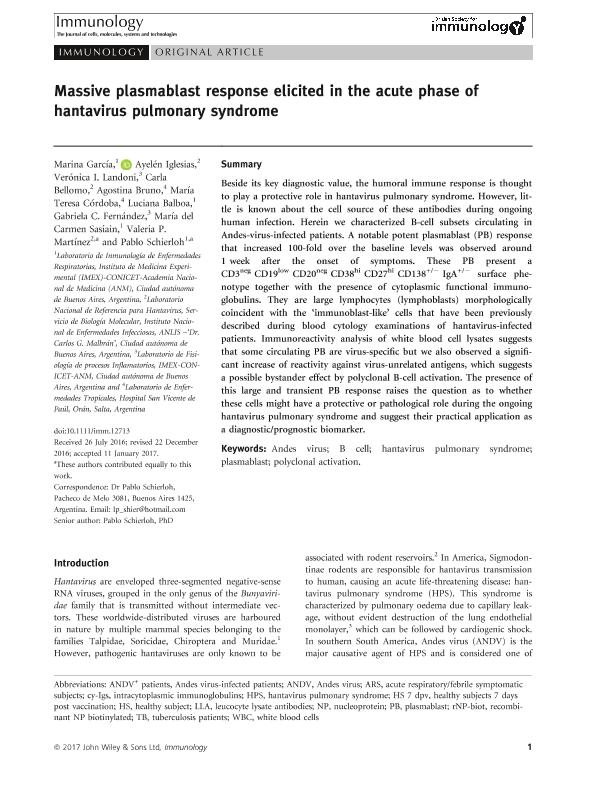Artículo
Massive plasmablast response elicited in the acute phase of hantavirus pulmonary syndrome
García, Marina; Iglesias, Ayelén Aluminé; Landoni, Verónica Inés ; Bellomo, Carla; Bruno, Agostina; Córdoba, María Teresa; Balboa, Luciana
; Bellomo, Carla; Bruno, Agostina; Córdoba, María Teresa; Balboa, Luciana ; Fernández, Gabriela Cristina
; Fernández, Gabriela Cristina ; Sasiain, María del Carmen
; Sasiain, María del Carmen ; Martinez, Valeria Paula; Schierloh, Luis Pablo
; Martinez, Valeria Paula; Schierloh, Luis Pablo
 ; Bellomo, Carla; Bruno, Agostina; Córdoba, María Teresa; Balboa, Luciana
; Bellomo, Carla; Bruno, Agostina; Córdoba, María Teresa; Balboa, Luciana ; Fernández, Gabriela Cristina
; Fernández, Gabriela Cristina ; Sasiain, María del Carmen
; Sasiain, María del Carmen ; Martinez, Valeria Paula; Schierloh, Luis Pablo
; Martinez, Valeria Paula; Schierloh, Luis Pablo
Fecha de publicación:
05/2017
Editorial:
Wiley Blackwell Publishing, Inc
Revista:
Immunology
ISSN:
0019-2805
Idioma:
Inglés
Tipo de recurso:
Artículo publicado
Clasificación temática:
Resumen
Beside its key diagnostic value, the humoral immune response is thought to play a protective role in hantavirus pulmonary syndrome. However, little is known about the cell source of these antibodies during ongoing human infection. Herein we characterized B-cell subsets circulating in Andes-virus-infected patients. A notable potent plasmablast (PB) response that increased 100-fold over the baseline levels was observed around 1 week after the onset of symptoms. These PB present a CD3neg CD19low CD20neg CD38hi CD27hi CD138+/− IgA+/− surface phenotype together with the presence of cytoplasmic functional immunoglobulins. They are large lymphocytes (lymphoblasts) morphologically coincident with the ‘immunoblast-like’ cells that have been previously described during blood cytology examinations of hantavirus-infected patients. Immunoreactivity analysis of white blood cell lysates suggests that some circulating PB are virus-specific but we also observed a significant increase of reactivity against virus-unrelated antigens, which suggests a possible bystander effect by polyclonal B-cell activation. The presence of this large and transient PB response raises the question as to whether these cells might have a protective or pathological role during the ongoing hantavirus pulmonary syndrome and suggest their practical application as a diagnostic/prognostic biomarker.
Archivos asociados
Licencia
Identificadores
Colecciones
Articulos(IMEX)
Articulos de INST.DE MEDICINA EXPERIMENTAL
Articulos de INST.DE MEDICINA EXPERIMENTAL
Citación
García, Marina; Iglesias, Ayelén Aluminé; Landoni, Verónica Inés; Bellomo, Carla; Bruno, Agostina; et al.; Massive plasmablast response elicited in the acute phase of hantavirus pulmonary syndrome; Wiley Blackwell Publishing, Inc; Immunology; 151; 1; 5-2017; 122-135
Compartir
Altmétricas



